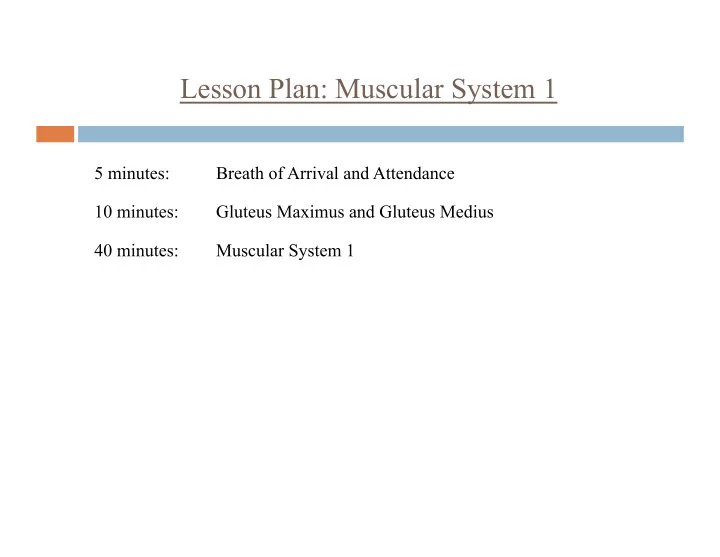

Mechanism of Contraction “Sliding Filament Mechanism” Excitation of the Sarcolemma: “The contraction of a skeletal muscle begins with a nerve impulse sent from the central nervous system through a motor unit (messages of inhibition are sent by different neurons and this will be covered in Somatic Nervous system). When the nerve impulse reaches the neuromuscular junction, acetylcholine is released into the synaptic cleft. It crosses the gap and binds with receptor sites on the motor end plate. From there an impulse is sent through the t-tubules into the sarcomeres triggering the release of calcium ions from the sarcoplasmic reticulum.”
Mechanism of Contraction “Sliding Filament Mechanism” Excitation of the Sarcolemma
Mechanism of Contraction “Sliding Filament Mechanism” Cross-Bridging: “Now that calcium is present in the sarcomere, it binds to troponin causing tropomyosin to slide off and expose the site allowing myosin heads to bind to thin myofilaments.”
Mechanism of Contraction “Sliding Filament Mechanism” Power Stroke: “Myosin heads, which are hinged at their base, then toggle in a mechanism similar to a light switch. This action causes thin myofilaments to slide toward the center of the sarcomere which shortens the overall length of the muscle fiber. Yeah! We have contraction!”
Mechanism of Contraction “Sliding Filament Mechanism” All or None Response: “When a motor neuron delivers a stimulus of contraction, all the muscle fibers of the motor unit receive the same signal at the same time. IF the stimulus is sufficient, THEN all muscle fibers associated with the motor unit will contract to its fullest extent; there is no partial contraction. Conversely, IF the stimulus is below the required threshold, THEN muscle contraction will not occur and the muscle fiber will remain at full resting length.”
Mechanism of Contraction “Sliding Filament Mechanism” Recruitment: “Numerous motor units are linked to a single skeletal muscle. The nervous system regulates the amount of muscular contraction by activating only the motor units needed to perform a given action. IF more strength is required, THEN additional motor units are recruited resulting in a stronger muscle contraction.”
Mechanism of Contraction “Sliding Filament Mechanism” Relaxation: “Almost immediately after the sarcoplasmic reticulum releases calcium ions into the sarcomeres, it begins to actively pump them back into its sacs. Freed from its chemical bond with the calcium ions, the tropomyosin slides back to cover the myosin binding sites on thin myofilaments. This action releases the myosin heads and returns them to their pre-contraction resting state. The muscle is now at rest.”
Energy Sources for Contraction Adenosine triphosphate Fuel Oxygen
Energy Sources for Contraction Adenosine triphosphate (AKA: ATP) The body's energy storage molecule. Fuel Glucose, fat, or, rarely, protein; used to form ATP in the mitochondria. By- products are CO2 and water (from aerobic metabolism), or, from the initial anaerobic process (which only uses carbohydrate, and not O2), lactic acid. Oxygen Combined with fuel in the mitochondria during aerobic metabolism, yielding energy (for making ATP) plus CO2 plus H2O.
Types of Skeletal Muscle Fibers Slow twitch Fast twitch Intermediate twitch
Types of Skeletal Muscle Fibers Slow twitch Skeletal muscle fibers that contract slowly and are fatigue resistant . AKA: red muscle. Examples: postural muscle, core muscle, legs of long distance runners.
Types of Skeletal Muscle Fibers Fast twitch Skeletal muscle fibers that contract forcefully and fatigue rapidly. AKA: white muscle. Examples: arm muscles.
Types of Skeletal Muscle Fibers Intermediate twitch Skeletal muscle fibers that are more fatigue resistant than fast twitch, and more forceful than slow twitch. AKA: pink muscle. Examples: legs of world class sprinters and arms of world class boxers.
Parts of a Skeletal Muscle Belly Origin Insertion
Parts of a Skeletal Muscle Belly The wide central portion of a skeletal muscle that contains the sarcomeres.
Parts of a Skeletal Muscle Origin Tendinous muscle attachment on the less movable bone or other structure. Typically medial or proximal to the insertion.
Parts of a Skeletal Muscle Insertion Tendinous muscle attachment on the more movable bone or structure. Typically lateral or distal to the origin.
Parts of a Skeletal Muscle Functional reversibility Property of some muscles that reverse the roles of the origins and insertions. Examples: iliopsoas during hip flexion.
Parts of a Skeletal Muscle Uniarticular Crosses one joint. Biarticular Crosses two joints and acts on both joints. Multiarticular Crosses more than two joints and acts on all joints.
Muscles Actions Prime mover Antagonist Synergist Fixator
Muscle Actions Prime mover Muscle responsible for causing a specific or desired action. AKA: agonist. Example: biceps brachii during elbow flexion.
Muscle Actions Anatagonist Muscles that must relax and lengthen or eccentrically contract and lengthen to allow actions of the prime mover to occur. Example: triceps brachii during elbow flexion.
Muscle Actions Synergist Muscle that aids movement by contracting at the same time as the prime movers. Example: pronator teres during elbow flexion with the forearm pronated.
Muscle Actions Fixator Specialized synergist muscles that act as a stabilizer . Example: deltoid during elbow flexion.
Types of Muscle Contractions Isotonic contraction Concentric contraction Eccentric contraction Isometric contraction
Types of Muscle Contractions Isotonic contraction Contraction in which muscle changes length . Concentric contraction Type of isotonic contraction where the muscle shortens . Eccentric contraction Type of isotonic contraction where the muscle lengthens .
Types of Muscle Contractions
Types of Muscle Contractions Isometric contraction Contraction in which muscle length remains the same.
Stretching and Stretch Receptors
Stretching and Stretch Receptors Stretching Method that lengthens/elongates soft tissues.
Stretching and Stretch Receptors Hyperflexibility Flexibility beyond a joint's normal range of motion. Contributes to joint instability. AKA: hypermobility.
Stretching and Stretch Receptors Muscle spindle Stretch receptor located within the muscle belly . Detects sudden stretching, causing the nervous system to respond by reflexively contracting the muscle.
Stretching and Stretch Receptors Golgi tendon organ Receptor located at the musculotendinous junction. Detects tension and excessive stretch, causing the nervous system to respond by inhibiting contraction.
Posture and Muscle Tone
Posture and Muscle Tone Posture How the body distributes itself in relation to gravity over a base or bases of support.
Recommend
More recommend